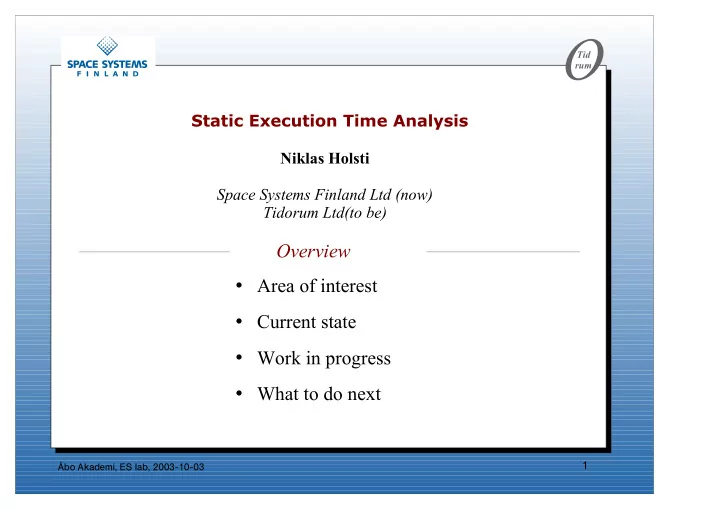

Tid rum Static Execution Time Analysis Niklas Holsti Space Systems Finland Ltd (now) Tidorum Ltd(to be) Overview • Area of interest • Current state • Work in progress • What to do next 1 Åbo Akademi, ES lab, 2003-10-03
Tid rum Area of interest • Static analysis of programs for – Bounds on execution time and memory space – other properties that depend on: • the possible execution paths • the time/space/energy usage along the execution path • the sequence of actions on the execution path (~ protocols) • Applications – analysis of executable (binary) programs – for embedded real-time systems – for verification (meets time and space limits) – for understanding (time and space per program part) 2 Åbo Akademi, ES lab, 2003-10-03
Tid rum Static execution-time analysis CPU speed model Bounds on Static (Sub)program code exec time analysis Bounds on input data Problem is unsolvable in general <= Halting Problem. - need restrictions on program structure - may get pessimistic (safe but inaccurate) results 3 Åbo Akademi, ES lab, 2003-10-03
Tid rum Current state = the Bound-T tool • Analyses worst-case execution time and stack usage – for deterministic processors (no cache, linear pipeline) • SPARC V7 (ERC32), ADSP 21020, Intel 8051, ARM7 (proto) – from compiled, linked binary (no source-code analysis) • Implementation – manually written (Ada 95) – modular: target-specific part + generic part • Generic techniques – program model = flow-graphs + call-graph + assertions – loop counters modelled by Presburger arithmetic (Omega tool) – worst-case execution path from ILP (lp_solve tool) – assertion language using syntactic structure of program 4 Åbo Akademi, ES lab, 2003-10-03
Tid rum Bound-T flow Source Compile WCETs Exe code Link Call Tree Assertions Bound-T Stack bounds HRT Execution Skeleton 5 Åbo Akademi, ES lab, 2003-10-03
Tid rum Work in progress • Increasing power of arithmetic analysis – Constant propagation to simplify program model – slicing along dependencies to simplify program model – optimized translation to Presburger formulae • Increasing power of flow analysis – Less constrained loop structures (DJ method) • Better analysis of dynamic addresses – case/switch statements, jump tables – array accesses, pointers to data or code • More powerful assertions – context-dependent (call-path dependent) assertions • Porting to more target processors 6 Åbo Akademi, ES lab, 2003-10-03
Tid rum EU research cooperation • ARTIST 2 Network of Excellence – proposal for EU 6th Framework Program – cluster: “ Compilers and Timing Analysis ” led by R. Wilhelm – participants: most EU WCET research groups • Saarbr ü cken, AbsInt, M ä lardalen, TU Wien, IRISA, York, SSF, ... – aims defined by “ integration ” purpose of NoE: • define common modular structure of WCET tools • interoperation of modules from various sources • adapt existing academic & commercial tools to conform – preparation for a larger FP6 WCET proposal in mid-2004 • ForTIA = Formal Techniques Industry Association – Mainly specification & verification tools, little analysis 7 Åbo Akademi, ES lab, 2003-10-03
Tid rum What to do next in R & D • Feasible paths – theory? representation? analysis? presentation? ... • Loops – nested loop dependencies, eg. triangular loops – inter-loop dependencies – non-counting loops: shifting loops, binary search, ... • Dynamic processor architectures – caches, parallel units, multiple issue, ... • Generative implementation of target-specific analysis modules – languages to describe target processors – trade-off: language power <=> implementation complexity 8 Åbo Akademi, ES lab, 2003-10-03
Tid rum Example of feasible path problem (real case!) procedure A is procedure B begin (act : in action_t; ok : out boolean) is for n in 1 .. 200 loop begin B (action(n), ok); Quick_Try (act, ok); exit when ok; if ok then end loop; Long_Comp (act); end A; end if; end B; • Expected WCET(A, B) ~ 20 ms • Syntactic paths (A, B) => Long_Comp 200 times => 4 seconds ! • Feasible paths (A, B) => Long_Comp once => 20 ms. 9 Åbo Akademi, ES lab, 2003-10-03
Tid rum This one could be solved by different design procedure A is begin for n in 1 .. 200 loop Quick_Try (action(n), ok); if ok then Long_Comp (action(n)); exit; end if; end loop; end A; • Syntactic paths (A, B) = Feasible paths (A, B) => Long_Comp once => 20 ms. • Perhaps “ inlining ” during analysis would see this, too. 10 Åbo Akademi, ES lab, 2003-10-03
Tid rum Research problems in feasible paths analysis • Formal representation – ? similar to flow graphs, or very different (other “ aspects ” ) – ? enumerative, linguistic, algebraic, automata, ... • Analysis – ? how: discover variable relationships, condition dependencies, ... – ? what: find the important path constraints, ignore trivial ones • Generality and usefulness – ? same or different path representation & analysis for • time analysis • memory analysis • points-to analysis • functional correctness & proof • etc. 11 Åbo Akademi, ES lab, 2003-10-03
Tid rum The End or the beginning? 12 Åbo Akademi, ES lab, 2003-10-03
Recommend
More recommend